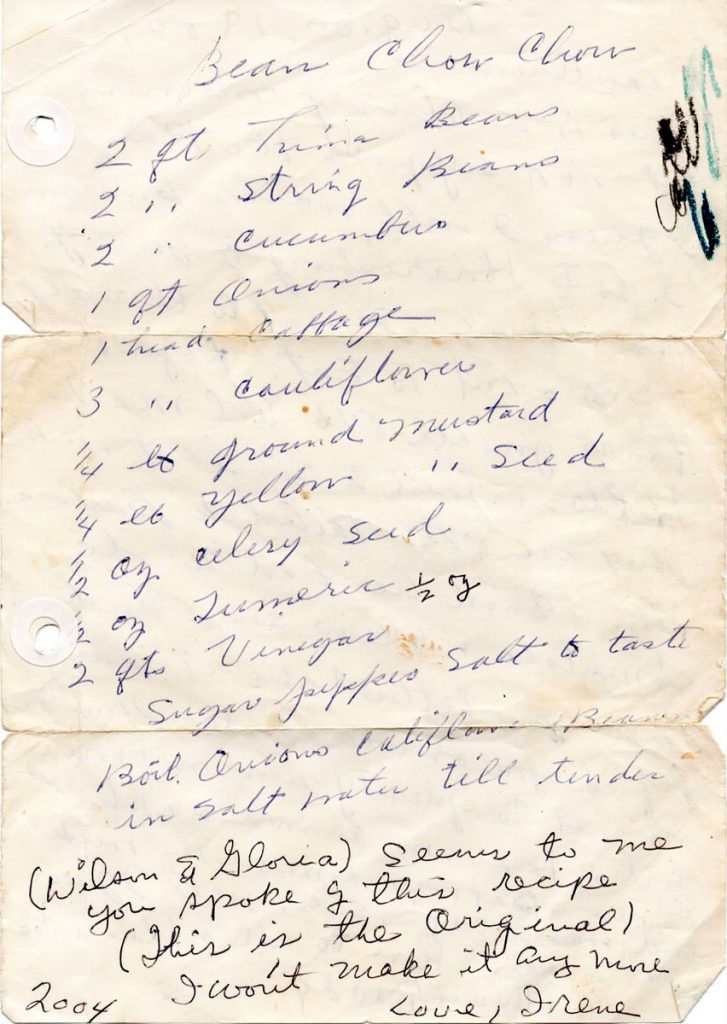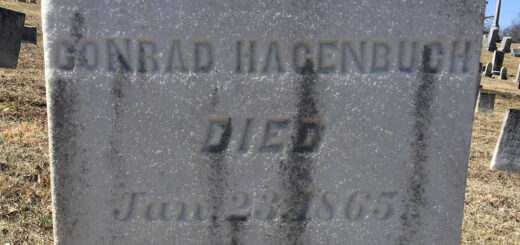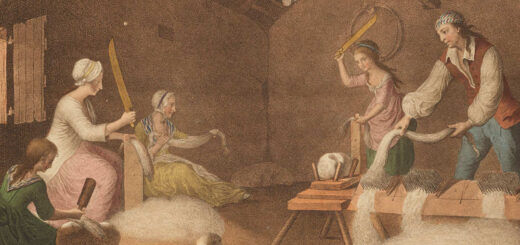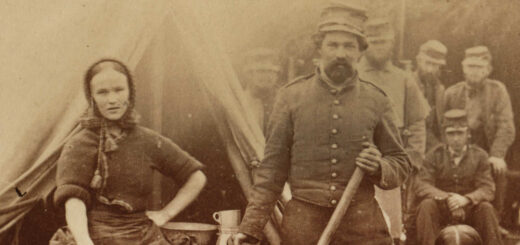Scraps of Paper: Recipe for Bean Chow-Chow
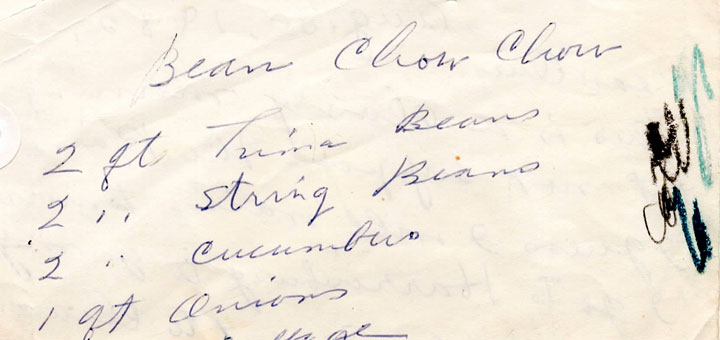
Over the years, this site has featured a number of articles detailing family artifacts and letters. Of particular interest to me are the scraps of paper containing the thoughts and scribbles of our ancestors. Not only do these help explain moments in family history, they also reveal the personalities of those who are no longer with us.
In December of 2016, my wife Sara and I visited my great aunt, Gloria (Felix) Faus (b. 1931), in southern California. Aunt Gloria is the sister-in-law of my grandmother, Irene (Faus) Hagenbuch (b. 1920, d. 2011), whom I called Nana. While discussing favorite family foods, Aunt Gloria mentioned that she had her mother-in-law’s recipe for bean chow-chow. Of course, her mother-in-law is my great grandmother, Minnie (Hilner) Faus (b. 1897, d. 1992), whom I called Grandma Faus. I asked to see the recipe.
Aunt Gloria opened a recipe book and pulled out a well-loved piece of paper. Sure enough, it listed the ingredients necessary to make the bean salad – a favorite among the Pennsylvania Deitsch. The recipe is as follows:
Bean Chow Chow
- 2 qts. lima beans
- 2 qts. string beans
- 2 qts. cucumbers
- 1 qt. onions
- 1 head cabbage
- 3 heads cauliflower
- 1/4 lb. ground mustard
- 1/4 lb. yellow mustard seed
- 1/2 oz. celery seed
- 1/2 oz. turmeric
- 2 qts. vinegar
Sugar, pepper, salt to taste. Boil onions, cauliflower, beans in salt water ’til tender.
Family recipes are treasures as valuable as photographs and other heirlooms. But this particular recipe was especially exciting, as it included additional scribblings on it.
First, at the bottom of the recipe was a note written in black ink from Nana to her younger brother, Wilson Faus (b. 1927, d. 2013), and his wife, Gloria. It reads as follows:
(Wilson & Gloria)
Seems to me you spoke of this recipe.
(This is the original)
I won’t make it anymore.
Love, Irene
2004
So for some unknown reason lost to history, Nana decided in 2004 that she would no longer be making this version of bean chow-chow. As a result, she mailed the original copy of the recipe to her brother and sister-in-law who had expressed interest in it.
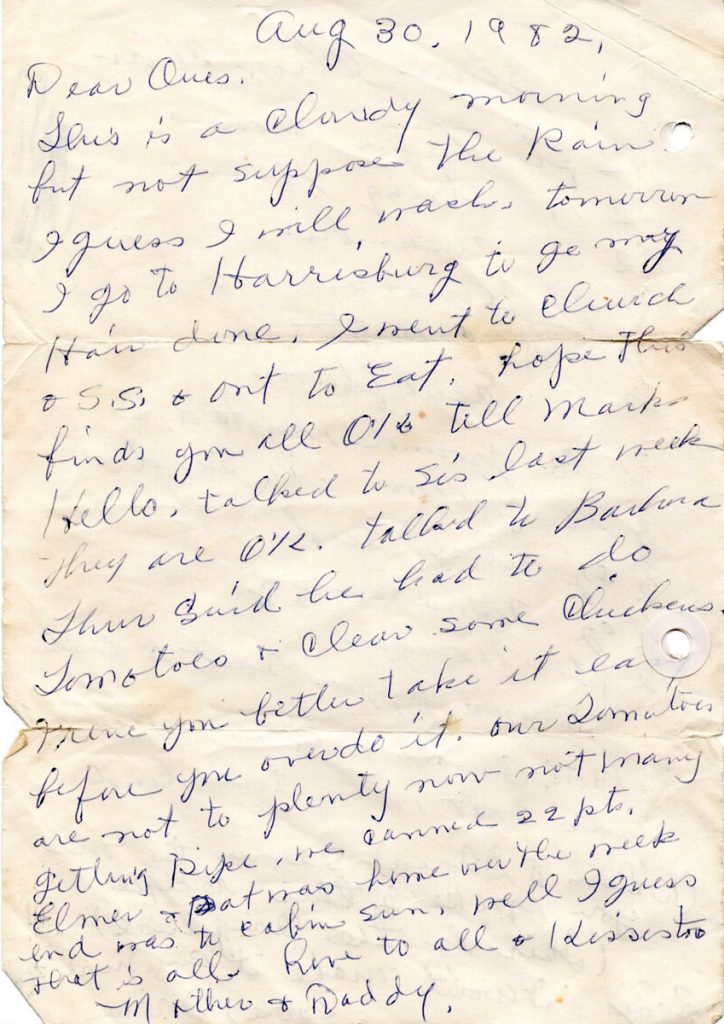
The reverse side of the bean chow-chow recipe – a 1982 letter from Minnie (Hilner) Faus “Grandma Faus” to her daughter Irene (Faus) Hagenbuch “Nana”
Curiously, though, the recipe itself was not in Nana’s handwriting. Turning it over makes this even more clear. The blue ink used to write the recipe had also been used to jot down a letter from Grandma Faus to her daughter, Irene (Nana). The letter was from 1982 and reads as follows:
August 30, 1982,
Dear Ones,
This is a cloudy morning but not suppose the [sic] rain. I guess I will wash tomorrow. I go to Harrisburg to get my hair done. I went to church & S.S. [Sunday School] & out to eat. Hope this finds you all ok. Tell Mark hello. Talked to Sis last week. They are okay. Talked to Barbara Thur. Said he [sic] had to do tomatoes & clean some chickens.
Irene, you better take it easy before you overdo it. Our tomatoes are not too plenty not, not many getting ripe. We canned 22 pts. Elmer & Pat was home over the weekend, was to cabin Sun. Well I guess that’s all. Love to all & kisses too.
Mother & Daddy
What I find wonderful about this letter is how absolutely ordinary it is. It captures the thoughts of a mother writing to her daughter, while also including a family recipe for bean chow-chow on the reverse side.
Much of the letter’s contents are recent family news. “Mark” is my father, Mark Hagenbuch, and “Barbara” is my aunt, Barbara (Hagenbuch) Huffman. Both are Irene’s children. “Sis” is Irene’s sister, Catharene (Faus) Lowe, and Elmer and Pat are her brother and sister-in-law.
Nana and Grandma Faus seemed to correspond about work and other tasks needing done. Grandma Faus tells her daughter not to “overdo it” while discussing her own chores like canning tomatoes and washing laundry. Reading the letter now, I can’t help but wonder what Grandma Faus and Nana would make of us pondering their words and thoughts found in the letter!
Today, communications like these are more fleeting, transmitted via phone calls, texts, and emails. Yet, for those of use who are lucky enough to have preserved scraps of paper containing the writings of our ancestors, we can glimpse images of their daily lives and personalities.

